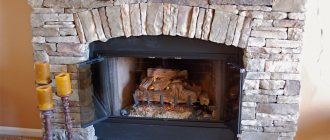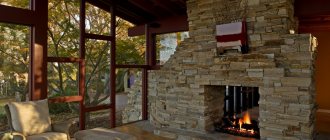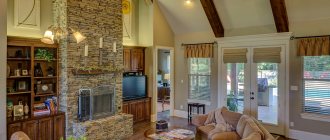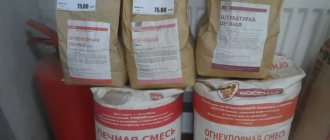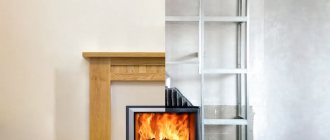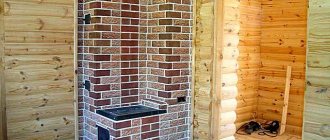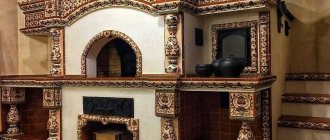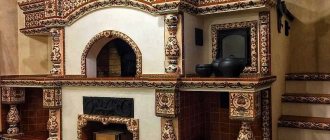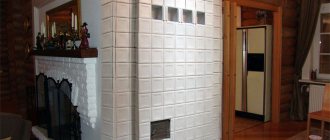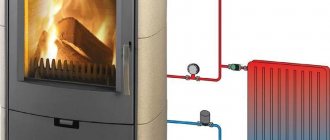A fireplace in a house or country house is a place of attraction for the whole family. It’s clear that you want it to be beautiful, but practicality also doesn’t hurt - soot and soot, dirt or tar from firewood, all this often ends up on the walls of the portal. For this reason, the surface must be easy to clean. In addition, the finish of the fireplace must be heat-resistant - although the sides of the fireplace do not heat up to the same temperatures as the stove, this requirement should not be neglected. Not many materials meet these requirements. This is heat-resistant plaster, special types of ceramic tiles and stone - natural or decorative.
Finishing features
One of the most important requirements for finishing a real fireplace is the fire resistance of the facing material. The structure consists of a hearth (the place where the fire burns) and a portal (the decorative outer part) with a chimney. The item is most often made from clinker - a special heat-resistant stove brick.
The color of the finish also matters. When the fireplace is intended primarily to heat the room, and not to decorate it, the darkest matte tones are preferable. The more textured and embossed the surface is, the stronger the heat transfer, which means the higher the temperature in the room with such a stove.
Frame covering
The finished frame is sheathed with sheet material.
Sheathing work includes three points:
- Taking measurements. It is more correct to take measurements for the cladding parts from the frame rather than from the drawing. Perhaps the dimensions somewhere will not coincide with the planned ones. If the frame is not very heavy, and there is a whole sheet to be cut, you can put the frame on the building material and trace its outline.
- Uncover . For accurate cutting, choose the appropriate tools for each type of material. Chipboard - jigsaw, plywood - circular saw, drywall - utility knife.
- Fastening to the frame . The casing is attached to the frame with self-tapping screws corresponding to the type of material. The caps of the screws go deeper into the part by a millimeter. Assembly should begin with fastening the shelf, because in some cases it will be fixed from the inside.
Expert opinion
Korzhavin Daniil Dmitrievich
Designer of stylish home furniture
For a mantelpiece, it makes sense to choose a material that is more resistant to mechanical stress: facade boards made of MDF, chipboard (veneered, laminated) or natural boards, followed by painting. And covering the rear wall of the portal with thin fiberboard will help lighten the structure.
Types and methods of finishing a fireplace
There are several options for finishing the portal, each of them has its own positive and negative properties. Most often, the hearth is plastered and then painted, lined with decorative ceramic tiles, natural or artificial stone, and sheathed with sheets of metal. The portal itself is often decorated with fireproof glass doors, heavy cast iron gratings, and steel shutters.
The cramped the room, the smaller the decorative hearth is made, the lighter its decoration.
Plastering: advantages, disadvantages
Finishing a fireplace with plaster is not a complicated or expensive process. Suitable for structures made entirely of brick and concrete. This design does not weigh down the object, so there is no need to further strengthen the foundation. The plaster layer, intended for subsequent finishing, is slightly different from the decorative option. When changing the interior, the structure can be easily repainted in a different color that matches the decor. The disadvantage of this finish is that when applying a thick layer, reinforcement is required, as well as long-term drying.
Tiling a fireplace - pros, cons
Very often, fireplaces are lined with ceramic tiles and porcelain stoneware. The latter is placed both directly on the glue and on metal profiles. Using porcelain stoneware it is easy to disguise uneven brickwork, chips, and other surface defects. The material is durable, resistant to frost, open fire, sudden changes in temperature, humidity, physical damage, and retains its beautiful appearance for a long time. The downside is that the price is not the lowest.
Cladding with ceramic tiles is an inexpensive option, since you can make it yourself or choose from the widest assortment now offered by most stores. In shape it is offered in square, rectangular, figured, corner, etc. The material is fire-resistant, environmentally friendly, and it can be chosen to suit almost any interior style. The disadvantage of the material is low impact resistance.
Decorating a fireplace with artificial stone - pros and cons
Artificial stone is cheaper than natural stone and vaguely resembles it in appearance. This material is several times lighter in weight - no additional strengthening of the foundation is needed for it. Frost resistance and resistance to chemicals in most species are also excellent. Fake stone is made from gypsum, stone chips, polymers, imitates granite, marble, onyx, sandstone. The material is easy to install by hand; there are flexible options for curved surfaces. Significant disadvantages - fake stone does not have the thermal conductivity of natural stone, as well as the corresponding characteristics of strength and moisture resistance; it is more fragile.
Finishing with natural stone: positive, negative qualities
Real natural stone is a heavy, beautiful, completely natural material. Such finishing always looks luxurious, it is voluminous, quite complex in execution, but extremely durable - the fireplace will last for more than one generation. It is permissible to install the structure even in a room that is not heated. The stone is abrasion-resistant, impact-resistant, and the variety of types, shapes, and colors allows you to choose it to suit different interior styles.
The construction of a structure on the first floor of a private house requires a reinforced foundation underneath; on the second and subsequent floors it is recommended to install the product at the junction of two main walls. Another disadvantage is the high cost of the material. For cladding use:
- marble;
- granite;
- sandstone;
- shell rock;
- soapstone;
- tuff;
- limestone.
Metal cladding - advantages, disadvantages
Decorating the hearth by sheathing it with metal sheets is suitable for many modern interior styles. The most popular finishing techniques are stainless steel, copper and brass, decoration techniques include broaching, embossing (including hand-made), artistic etching, and plasma cutting. Metals can be easily combined with natural or artificial stone and plaster. The undoubted advantages of such finishing are the relatively light weight of the parts, the ability to decorate the fireplace in almost any interior style (retro, classic, hi-tech, etc.) without completely rebuilding it. A free-standing structure made entirely of metal is easy to connect and place anywhere in the space. The main disadvantages are the likelihood of serious burns when touching a metal surface, uneven heating of the room, and rapid cooling.
Questions on the topic
Is it possible to assemble a structure without a frame?
You can try, but in this case, embedded bars are used, to which the sheathing parts are attached.
What thickness should I use for sheathing sheets?
The recommended thickness of gypsum plasterboard is 1.25 cm, plywood is 0.8 cm and more, chipboard and MDF is 1-1.2 cm.
What thickness of bars should I use for the frame?
30 × 30 or 40 × 40 mm is quite enough for a stable structure.
Is it necessary to putty drywall before painting?
Yes, putty adds strength and moisture resistance to gypsum boards. The paint applies evenly to such a surface, without stains.
Is it possible to glue polyurethane decor without special tools? For putty and sealant?
It is possible to glue it, but it is not advisable, because... Over time, cracks will appear, especially in places where parts join.
Is it necessary to paint a putty portal and polyurethane stucco?
Well-made putty looks like you don’t want to paint it. But this must be done, because after a while its snow-white color will begin to turn yellow. Polyurethane does not change its color, but without painting, all joints of moldings and other elements will be visible.
What material can be used to decorate radius facades with stucco?
Only polyurethane products are suitable for finishing radius facades. They are quite elastic and can be bent. Polystyrene moldings have a much lower density and are not as flexible. They are more likely to be damaged during installation.
How to choose plaster for a fireplace
To decorate the fireplace insert, chimney and other parts, you will need to choose the right plaster. The composition is often mixed independently using the following main components:
- clay – added for heat resistance. It is advisable to choose something that is not too “greasy” - it will quickly crack when the structure being designed is heated;
- sand - it is not afraid of high temperatures, the coating is as durable as possible, its volume is approximately twice as large as clay;
- lime is an excellent plasticizer, improves adhesion to the base, and facilitates the application process. It is recommended to purchase ready-made slaked fluff or make it yourself;
- asbestos, fiberglass - increase the thickness, heat resistance, and strength of the coating. It is preferable to add up to 7-10% natural fiberglass to the solution, even less asbestos, since it is very toxic;
- cement - as a binding component, it is added no more than 50% of the total volume of the mixture, since a larger amount will lead to cracking of the surface.
If you have no experience in preparing multicomponent mixtures, it is better to buy a ready-made plaster composition for stoves.
How to plaster yourself
Plastering the structure yourself is not too difficult. It is only important to choose a special composition - fire-resistant, when heated, does not release harmful substances into the surrounding atmosphere, and does not crack under the influence of high temperatures.
How to perform plastering step by step:
- before starting work, the walls of the structure are cleaned of dirt, degreased, slightly heated, and the masonry is moistened with water;
- then reinforcement is made using a special mesh to make the coating as durable as possible;
- then spray with a liquid solution - this allows you to fill the pores in the brickwork;
- when the layer has slightly set, plastering is carried out - a layer of four to six mm is applied. thick. To do this, use a trowel and a trowel;
- then apply another one or three of the same thin layers and dry;
- The covering is made with the same liquid mixture as the spray; it helps to hide the smallest defects. The plane is leveled until it hardens completely, using a wooden smoother;
- It is permissible to heat the stove after three to four days - speeding up the drying process with kindling is unacceptable, since the coating often cracks;
- the textured coating is made very thin - 0.3-0.7 cm, so that the finishing does not weigh down the structure;
- Decorative plaster is rarely tinted, so you will have to add the paint yourself. It is chosen to be heat-resistant - up to +650 degrees; silicone enamel, which almost never cracks, is best suited.
Soapstone chlorite sounds nice, but is it profitable?
A well-organized marketing campaign works wonders. Therefore, today there are rave reviews about soapstone chlorite everywhere. It is a common volcanic rock, heavy, strong and heat resistant. No one can clearly answer why it is better than basalt, granite or sandstone. But in cost it is not inferior to elite marble delivered from Italy (from 7,000 rubles per 1 m2).
So far, soapstone chlorite has “taken root” only in baths and saunas, where heaters are lined with it. You can use it to decorate the fireplace and stove, but there are also more economical options.
The color range of this stone is quite poor. It is dominated by pale gray and greenish shades.
Which tiles are suitable for finishing a fireplace?
Basic selection options:
- impact resistance, wear resistance - directly affect the durability of the coating;
- design – the appearance of the fireplace should match the style of the room;
- moisture resistance – if there is water in the room (sauna, bathhouse);
- resistance to temperature changes - very important if the fireplace is the only source of heating in the room;
- thickness - the more the better, it is recommended that the option is no thinner than eight mm;
- porosity – it is advisable to use low porosity, as it is more durable;
- marking tiles - the use of category “A” is more acceptable, since the dimensions of the product are as accurate as possible, the pattern is clear, which is very important when laying out complex patterns.
There are many types of finishing materials based on ceramic tiles:
- terracotta is a strong and durable material, frost-resistant and vapor-tight. The tiles do not split upon impact, are practically scratch-resistant, are suitable for damp, heated and unheated rooms, and can be attached to any surface. A fireplace decorated with terracotta tiles heats up longer than others, and the coating tolerates sudden temperature changes well;
- tiles - used for highly artistic finishing of stoves, most often covered with glaze, almost any design can be applied. The heat transfer of the product is high, it is easy to care for, but the cost of the material is high;
- porcelain stoneware – combines the best properties of granite and ceramics, is resistant to temperature changes, does not crack, does not mold, does not fade in the sun, and is available in various color options;
- clinker tiles - made from several types of clay, with the addition of fireclay powder. The thickness of the material is 9-13 mm, it is easily installed using hot-melt adhesive, but when decorating a summer kitchen, the latter is frost-resistant. Clinker tiles are low-porous, wear-resistant, impact-resistant;
- majolica - has been used since ancient times; its composition is an improved terracotta, with a pattern applied to it, covered with a transparent glaze. The price of the material is high,
- tiles are heat-resistant and tolerate temperature changes well, but in the cold the material quickly deteriorates and crumbles. Matte options are preferable for fireplaces - they do not crack. Installation is carried out using heat-resistant compounds or without glue - in a metal frame;
- fireclay tiles - made from stone flour and refractory clay, are acid-resistant, fire-resistant, can withstand extremely low temperatures, and do not wear off.
DIY tile installation technology
For self-installation, purchase a special composition - tile adhesive. On the back side of the tiles there are usually special notches that increase the adhesion of the parts to the base. It is recommended to reinforce the structure with large-mesh reinforcing mesh, secured with screws or nails. Next, the mesh is covered with a mixture of sand, clay, high-grade cement, with the addition of polymers. The seams are grouted so that they are even; special plastic crosses are used when laying. The evenness of the coating is checked with a level and plumb line.
Tips and tricks from professionals
To make the fireplace cladding look attractive, the following nuances should be taken into account:
- When constructing and finishing a structure, it is important to use a building level.
- After creating a fireplace with your own hands, irregularities often appear. They definitely need to be removed.
- When decorating the surface, you need to use a spatula and a sponge. This will help you achieve better results.
- It is recommended to plaster the fireplace using a small brush and trowel.
- For high-quality cladding you will need good equipment.
- To get a unique design, you should use different shades of tiles. They can be combined in different ways.
- To retain heat as much as possible, it is better to use tiles. They have a large thickness and relief structure.
- To make the marble pattern monolithic, you must first lay out the tiles on the floor.
Tiles retain heat best.
Choosing artificial stone for finishing
Artificial stone is made from gypsum, synthetic materials, most often with the addition of stone chips. Some of its types are externally indistinguishable from the real thing. High-quality design is achieved with the right choice of materials.
Main criteria:
- price - a good stone is never excessively cheap, but foreign products are always an order of magnitude more expensive than domestic ones;
- goods used for finishing residential premises must have a certificate of conformity and hygiene, and not contain harmful components;
- the longer a manufacturing company exists, the more likely it is that it produces high-quality material;
- the stone should not be too porous - this affects the strength and service life of finishing elements;
- The manufacturer's logo must be indicated on the packaging; the date of manufacture is also important - the optimal strength of the artificial stone is achieved within 28-30 days from the date of manufacture. If the period is shorter, the product is of poor quality, it is better to refuse to purchase it.
Features of working with artificial stone when decorating a fireplace
Decorating a hearth with fake stone has a number of features:
- work is performed at a temperature of at least +6 degrees;
- it is important to use the appropriate adhesive recommended by the manufacturer;
- for cutting use a hacksaw;
- the surface of the product is cleaned, a reinforcing mesh is installed on it;
- then plaster is applied to the mesh, the layer thickness is 0.9-1.5 cm, and dried;
- cladding is done from the corner from top to bottom so that the parts do not get dirty;
- a thick layer of mortar is applied to each part with a trowel, pressed to the place to be decorated, and excess glue is removed;
- it is advisable to use long and short parts in turn, adjusting them with a hacksaw or wire cutters;
- all seams are filled with mortar, dried, and excess is removed;
- After complete drying, the structure is coated with hydrophobic compounds to increase the service life of the coating.
Plastering works
To proceed to the final finishing of the fireplace portal, it is necessary to properly prepare the surface of the casing: get rid of joints, irregularities and cracks. Plaster will help in this matter.
- The entire surface of the fireplace is carefully primed.
- The edges of the plasterboard joints are cut at an angle of 45 degrees, as if forming a furrow. The seams are filled with plaster, serpyanka (reinforcing mesh) is placed on top and the seam is leveled with a wide spatula.
- All holes for self-tapping screws are covered with plaster, applying it crosswise.
- Beautiful, even corners are formed using a perforated corner. The solution is applied to adjacent sides, and a perforated corner is attached to it. An additional layer of plaster is used to smooth out the seam so that the corner is not visible.
- After the seams, joints and recesses have dried, they are sanded with fine sandpaper and re-primed.
The need for complete plastering and puttying of the surface depends both on the covering material and on the further method of facing the false fireplace.
It is necessary to plaster before painting. But in terms of the number of layers of plaster and putty, it is better to focus on the characteristics of the material. So for gypsum plasterboard it is enough to apply 2 layers of finishing putty, bypassing the plaster. But with chipboard you will have to tinker to get a flat and smooth surface. It is also advisable to use reinforcing mesh over the entire area. The last layer is always finishing putty.
Choosing natural stone for facing a fireplace
Cladding with real stone involves a wide variety of materials. Marble and travertine, sandstone and granite, tuff and limestone are suitable for work. When choosing the appropriate option, you should remember that smooth materials require less maintenance and cleaning from dirt. Stones such as granite and marble have a significant weight, which will require a very solid foundation for the fireplace. It is equally important that the chosen decor fits well into the interior.
Properties of different stones:
- sandstone is layered, has a wide range of colors (from red-pink to dark gray), changes color when the light changes, and is resistant to temperature changes;
- slate - can be red, yellow, green, brown, black, etc., is relatively expensive, requires periodic treatment with dirt-repellent mixtures;
- travertine - usually yellowish-gray in color, porous, not too dense, therefore to improve its properties it is coated with special compounds;
- granite is the most durable, reliable, durable, resistant to impacts, chemicals, and temperature changes. The color range is from white-gray to almost black, from pale yellow to dark burgundy. The price is very high, but the appearance is strict and solid;
- marble looks luxurious, but is expensive. Colors – white, gray, black, variegated. The material easily tolerates temperature changes and physical influences, but is not resistant to aggressive chemicals or household dyes, therefore it needs a special coating;
- Onyx is a semi-precious stone, the presence of which in a room makes it unique. The material transmits light perfectly, comes in yellow, green, orange, brown, is resistant to high and low temperatures, but chemicals are destructive to it, and the cost is about three times more than other stones.
Rules for working with marble and other natural stones
Working with real stone, be it marble, granite, sandstone or others, is labor-intensive. Each tile will have to be carefully adjusted in size and selected according to tone. To work, you will need special grinding machines and stone-cutting devices.
Installation order:
- the surface of the stove is cleaned of dirt, a reinforcing mesh is installed;
- facing elements are adjusted so that all tiles are the same size, shade, thickness;
- installation begins with the largest parts, secured with tile adhesive;
- culling, if necessary, is used in inconspicuous places;
- in order not to confuse the locations of individual tiles, they are marked on the reverse side;
- It is advisable to add compounds to the adhesive that increase its elasticity; the material should not get on the front side of the tiles;
- work begins from the lower left corner, observing the order: left to right, bottom to top;
- for tiles with a thickness of over 10 mm, additional wire reinforcement is used;
- The seams are grouted two days after installation, being careful not to stain the material with grout.
Frame making
Regardless of the material used for the frame, the assembly principle is the same:
- According to the drawing, guide supports are cut: there should be as many of them as there are ribs in the shape of the fireplace. For example, if a fireplace is U-shaped without protruding elements and a base, then it has 8 vertical and 14 horizontal ribs. In addition, additional connections will be needed, the so-called stiffeners, which give the structure stability. Their number and fastening step depend on the size of the frame.
- Using self-tapping screws (for wood or metal, respectively), the front planes (the bases for the facade and rear wall) are assembled from the supports.
- The resulting blanks are additionally strengthened with stiffening ribs, which prevent the structures from “walking.”
- The blanks are connected to each other by horizontal ribs. As a result, the frame gains volume.
- The frame is checked for stability and mobility of elements. If the structure is movable, additional ribs are added.
When you plan to install a false fireplace to the wall, you should start by transferring the markings and screwing the frame elements directly to the wall.
Stylistic directions in fireplace decoration
Various types of stoves are built into very different interiors. It is important to maintain the integrity of the interior and select an acceptable color scheme. A fireplace is often a zoning detail that allows you to neatly divide a spacious room into two functional parts. Most often, fireplaces are built into classicism, baroque, loft, Provence, and country interiors.
In English style
The hearth in the English style is U-shaped, equipped with a large firebox and a wide mantelpiece. Suitable finishing materials are valuable wood species (wenge, zebrawood, bog oak, Karelian birch, etc.) or their high-quality imitation, ceramic tiles, metal (forged elements). Most of the lines here are smooth, the corners are strictly straight, all the details have a strictly regular shape.
Provence style
The Provence fireplace has the simplest possible shape, but every detail is worked out to the maximum. The color of the structure is usually white, other suitable colors are pastel, cream, pale pink, bluish, soft green. Suitable materials include decorative plaster, ceramic tiles with floral patterns, and light wood, including painted and artificially aged wood. Forging will also come in handy.
Country style
Country is a style associated with rustic simplicity and comfort, which is why the fireplace here is finished “modestly, but tastefully.” This design is rather heavy and very voluminous, so independent finishing is very labor-intensive. The portal itself is D-shaped; above the firebox there is a thick beam, most often stone. For decoration, artificially aged natural stone (shell rock, sandstone), brickwork, imitation stone, brick are suitable.
Classic style
Classic is usually associated with harmony, symmetry, correct geometry, both of the object itself and of the entire room where it is located. A few stucco elements are allowed here - moldings, rosettes, half-columns, pilasters, corner parts, etc. Forged, ceramic tiles made in light colors with unobtrusive decor, including those imitating wood, are also acceptable.
High-tech style
A fireplace in high-tech style is necessarily smooth and shiny. Rarely is it located against a wall - usually these are located in the corner, island, suspended, rotating structures. The main finishing materials are metal, glass (fireproof, transparent, patterned, partially tinted, etc.).
Fire-resistant glass is characterized by high heat transfer, which is why it is used in structures created specifically for heating.
In ethnic style
Ethnic fireplaces - colorful oriental and strict European designs. Less often, it is an imitation of a “Russian stove” fit into the corresponding interior. Popular finishing methods are decorative plaster, whitewashing with chalk, coating with clay mixed with various dyes, mosaic of colored ceramic tiles. There are no patterns here at all, or they are as winding and multi-colored as possible.
Loft style
A loft fireplace is always decorated in an antique style, finished with brick, stone, dark metal, rough wood, and less often with plaster and stucco. The structure is usually placed near the wall, but island and hanging options are acceptable; the shape is rectangular, round, in the form of a barrel, etc. The chimney here is not disguised, but is made accent. Also, the hearth may resemble a slightly modernized “potbelly stove” located in an empty niche.
Decoration of the fireplace area
You should not decorate just the fireplace, otherwise it will look like a foreign body. In order for the composition to look harmonious, you also need to use the fireplace area: the floor, walls and the space above the mantelpiece.
How to decorate the floor near the fireplace?
If we are talking about an operating furnace, then the floor near it should be made of non-combustible materials. An accidental spark or ember falling from the portal can lead to a fire. Therefore, the design of a fireplace stove in a wooden house should be made of wild stone, refractory brick or tile.
But at a safe distance from the active fireplace, it is quite possible to spread a fluffy blanket, carpet or fur skin. In this case, reclining near the fireplace can become the highlight of winter evenings.
You can place anything on the floor near the false fireplace: vases, candles, figurines, soft toys, etc. The main thing is that the space is not cluttered and decorative elements do not interfere with free passage.
To add authenticity to the fake portal, you can install an imitation poker or firewood rack with logs next to it.
Decorating the walls and space above the fireplace
The fireplace itself evokes interest, and the effect can be enhanced with the help of details that attract attention. A clock or a mirror are good for these purposes. The gaze will involuntarily dwell on these objects, focusing on the fireplace area.
You can also play on the opposite effect. In this case, the fireplace itself will become the anchor that catches the eye - and near it you should place those objects to which you need to draw attention. For example, family photographs with pleasant moments captured on them. Such a psychological technique can create a favorable atmosphere in the family on a subconscious level, constantly reminding you of the most significant events.
Also, the fireplace area can serve as a connecting link. With this approach, the decorations located around the fireplace are selected taking into account the interior of the room and the design of the fireplace itself.
So, you can decorate the fireplace area for the New Year with paper garlands and New Year’s flags made by yourself. And by March 8, place bouquets with primroses on the walls instead of a Christmas tree garland. This way the fireplace area will be perceived as a natural part of the room, complementing the surroundings and setting the mood.
Finishing options for false fireplaces
Not every private mansion will be able to install a real fireplace; in a city apartment, to install it, you will have to visit several authorities, draw up a project, and with a high degree of probability receive a refusal. Therefore, where it is impossible to create a real hearth, they create a portal for a fake one. The fire in it is painted or made of fabric, driven by air, which is sometimes accompanied by the sound of crackling firewood.
Artificial fireplaces are made one-sided, three-sided, less often - viewed from all four sides. By type they distinguish wall, corner (convex and concave), island pseudo-foci; by shape - square, cylindrical, “pyramids”, etc.
The finishing of such a design is simpler than that of a real one - the false fireplace does not heat up and is completely fireproof, therefore the requirements for finishing relate, first of all, to the appearance of the product. The portal is decorated with plasterboard, wood, various types of ceramics, and stone.
Hearth lighting
If a real fire is not provided for in the design of the fireplace, then an artificial one can be made. Depending on the method of imitation, the “flame” inside the portal can be either very conventional or as reliable as possible.
Most often, to illuminate the fireplace inside the hearth, they use:
- LED strips. They can be one color, or several shades to create highlights of the flame. LEDs are universal lighting. They are suitable for all types of false fireplaces. In addition to “fire”, in this way you can recreate “smoldering coals” by filling the LED strip with painted stones and sand or real coals and ash;
- Christmas tree garlands. This type of lighting is most often used when decorating a fireplace for the New Year and Christmas, but monochrome garlands are also common during other periods of the year;
- steam installations. The combination of steam, LEDs and fan creates not only a very realistic flame, but also “smoke”. The effect is very realistic. But if this lighting method is suitable for a fireplace made of plasterboard or polystyrene foam, then the cardboard may become soggy from excess moisture;
- candles. A very impressive, but dangerous way to illuminate a portal. It is not recommended to be used for illuminating false fireplaces made of highly flammable materials, as well as in rooms where there are small children and pets;
- fabric and ribbons. To recreate the flame, scraps of light fabrics in fiery shades are taken. Under them there is a small fan and lighting. With the correct selection of tones and textures, the chaotic movement of the fabric combined with the glare of “sparks” will create a very realistic “flame”.
By changing the way the hearth is lit, you can completely change the “mood” of the fireplace. Candle lighting will add romance to Valentine's Day. A shimmering Christmas tree garland illuminating the portal will add a New Year's mood.
About tiles
The tiled stove is a truly luxurious structure, even if it is dilapidated, see fig. However, tiling is definitely not the kind of work that can be done by studying the technology from the descriptions; This is an even more delicate matter, requiring experience and accuracy than cladding with natural stone.
Tiled stoves and fireplaces
Tiles are generally prepared from the same kaolin mass as high-quality tiles. To harmonize with TKR and improve the heating technology of the furnace, the tiles are molded into box-shaped ones with a cavity - a tiller, pos. 1a next rice. – which is filled with sand during the cladding process. You need mountain sand with rough grains and a minimal admixture of clay; it does not swell, does not sinter or cake due to cyclic heating. The tiles are placed on a greasy clay mortar; The clay used is white, the sand is the same mountain sand. Add half a glass to a glass of table salt to a bucket of the prepared solution.
Cladding the stove with tiles
Before facing, the tiles are laid out and sorted out, as in the case of wild stone, achieving evenness in the rows. The dimensions of the tiles have been standardized by GOST since 1947, but the tolerance is quite wide, approx. 1.5 mm. It is impossible to achieve less due to the properties of the material itself. With a cladding height of 10 rows, the spacing of the seams can reach 15 mm, which, as you understand, is in no way acceptable.
Note: the base of large artistic panels on tiles is laid out and adjusted by hand at the factory. Therefore, tiled panels are very expensive, but they are put in place without layout.
The tiling is done in order, tying the tiles together with steel pins and wire. As a rule, the stove is lined with tiles in the order of its construction, and the lining must always be ahead of the masonry, as shown in pos. 3. In this case, the tiles are knitted with anchor loops, as in pos. 1b. Some craftsmen (qualitatively few) know how to tile walk-in stoves; in this case, knitting is done with anchor pins, pos. 2.
